Ferns and
Fern Allies in the Canberra Region
Polystichum proliferum
- Mother Shield Fern
Polystichum proliferum
is a very hardy ground fern that is widespread on the mountainsides
to the west of Canberra.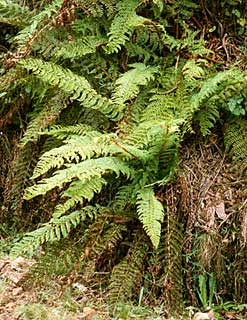 It colonises wide areas both by propagating via proliferous tips at
the end of its fronds, and by spores. It is often assoicated with Dicksonia
tree fern gullies, growing higher up the slopes, further away from the
watercourse than the tree ferns. It grows from a central rhizome, with
fronds up to a metre (3') in length. Its fronds are usually a dull darkish
green. With age the fern may develop a trunk-like base. To the untutored
eye, a large P. proliferum can look like a young tree fern.
It colonises wide areas both by propagating via proliferous tips at
the end of its fronds, and by spores. It is often assoicated with Dicksonia
tree fern gullies, growing higher up the slopes, further away from the
watercourse than the tree ferns. It grows from a central rhizome, with
fronds up to a metre (3') in length. Its fronds are usually a dull darkish
green. With age the fern may develop a trunk-like base. To the untutored
eye, a large P. proliferum can look like a young tree fern.
There are several varieties of Polystichum
in Australia but it is not at all clear that all species have been fully identified
or described. Polystichum australiense has also be tentatively identified
from the Canberra region.
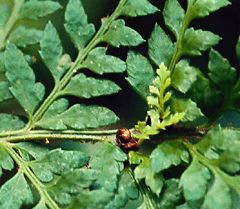 P.
proliferum is so named because of the proliferous buds it grows on its fronds.
These start as a bud and grow into a small plant, towards the end of the frond,
before the frond sags to the ground and the new plant takes root. The image to
the right shows a young proliferous bud. P.
proliferum is so named because of the proliferous buds it grows on its fronds.
These start as a bud and grow into a small plant, towards the end of the frond,
before the frond sags to the ground and the new plant takes root. The image to
the right shows a young proliferous bud.
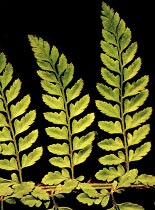
The pinnae of most specimens of P. proliferum in the Canberra
region look like the image at right. Note the groove running along the
stipe (frond stalk) and the brown scales. Some specimens, however, show
a distinctly different appearance. These have tended to be clumped into
the same species, but this is something that needs to be checked carefully.
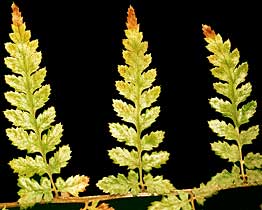 One plant we found in the Blue Range, growing under a waterfall (not
the usual place for P.proliferum) was distinctly different, both
in the shape of the pinnae and the black hair-like scales on the base
of the rhachis (stalk). At a distance, too, there was something quite
"different" about its appearance, which attracted our attention.
Compare this image with the one above to see how the pinnae of the two
specimens differ. The photos are of plants collected within a few metres
of each other. We intend to look for more specimens of the "new"
variety.
One plant we found in the Blue Range, growing under a waterfall (not
the usual place for P.proliferum) was distinctly different, both
in the shape of the pinnae and the black hair-like scales on the base
of the rhachis (stalk). At a distance, too, there was something quite
"different" about its appearance, which attracted our attention.
Compare this image with the one above to see how the pinnae of the two
specimens differ. The photos are of plants collected within a few metres
of each other. We intend to look for more specimens of the "new"
variety.
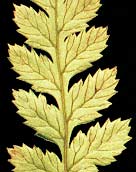
The veination of the pinnae, and especially the way in which the pinnae
are attached to the stipe, are quite distinctive. The image at right,
of the underside of the frond, shows this clearly. Taken together with
the black hair-like scales, there's a good case for this being a new
species. It is this sort of discovery that can make one's efforts really
rewarding.

 David
Nicholls David
Nicholls
July 1998
|
 It colonises wide areas both by propagating via proliferous tips at
the end of its fronds, and by spores. It is often assoicated with Dicksonia
tree fern gullies, growing higher up the slopes, further away from the
watercourse than the tree ferns. It grows from a central rhizome, with
fronds up to a metre (3') in length. Its fronds are usually a dull darkish
green. With age the fern may develop a trunk-like base. To the untutored
eye, a large P. proliferum can look like a young tree fern.
It colonises wide areas both by propagating via proliferous tips at
the end of its fronds, and by spores. It is often assoicated with Dicksonia
tree fern gullies, growing higher up the slopes, further away from the
watercourse than the tree ferns. It grows from a central rhizome, with
fronds up to a metre (3') in length. Its fronds are usually a dull darkish
green. With age the fern may develop a trunk-like base. To the untutored
eye, a large P. proliferum can look like a young tree fern. P.
proliferum is so named because of the proliferous buds it grows on its fronds.
These start as a bud and grow into a small plant, towards the end of the frond,
before the frond sags to the ground and the new plant takes root. The image to
the right shows a young proliferous bud.
P.
proliferum is so named because of the proliferous buds it grows on its fronds.
These start as a bud and grow into a small plant, towards the end of the frond,
before the frond sags to the ground and the new plant takes root. The image to
the right shows a young proliferous bud. 
 One plant we found in the Blue Range, growing under a waterfall (not
the usual place for P.proliferum) was distinctly different, both
in the shape of the pinnae and the black hair-like scales on the base
of the rhachis (stalk). At a distance, too, there was something quite
"different" about its appearance, which attracted our attention.
Compare this image with the one above to see how the pinnae of the two
specimens differ. The photos are of plants collected within a few metres
of each other. We intend to look for more specimens of the "new"
variety.
One plant we found in the Blue Range, growing under a waterfall (not
the usual place for P.proliferum) was distinctly different, both
in the shape of the pinnae and the black hair-like scales on the base
of the rhachis (stalk). At a distance, too, there was something quite
"different" about its appearance, which attracted our attention.
Compare this image with the one above to see how the pinnae of the two
specimens differ. The photos are of plants collected within a few metres
of each other. We intend to look for more specimens of the "new"
variety.